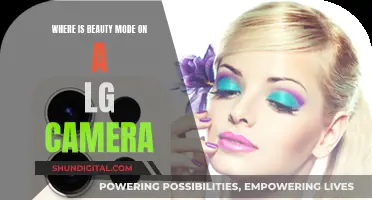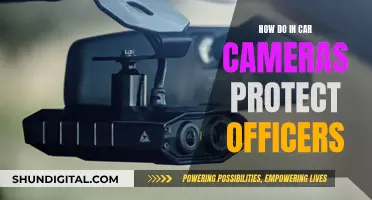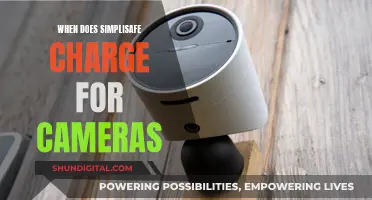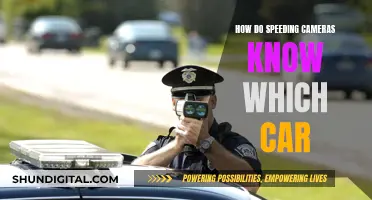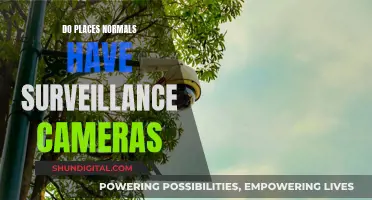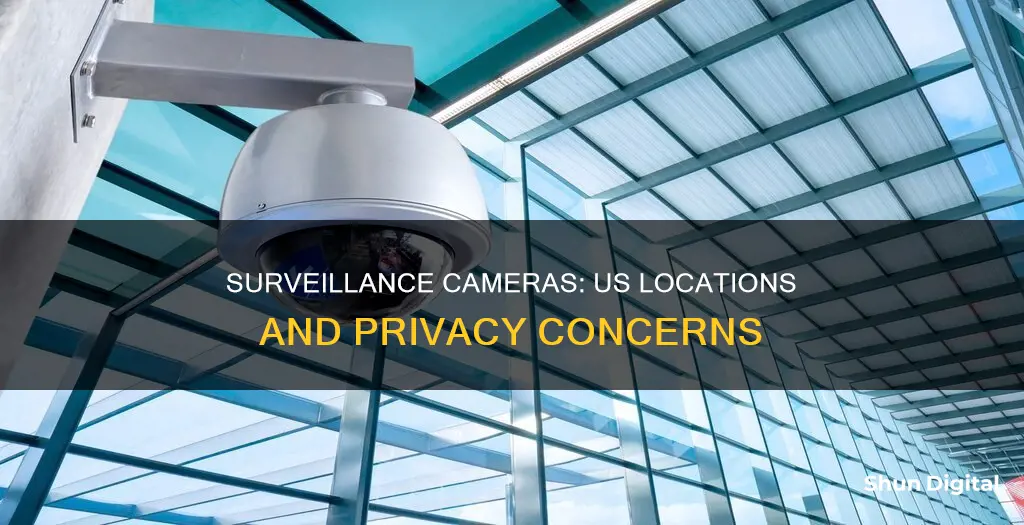
Surveillance cameras are everywhere in the US, with about one camera for every four people. While there are no federal laws prohibiting video surveillance in public, laws vary from state to state. In some states, such as New York, Rhode Island, and California, video cameras are prohibited in places where individuals have a reasonable expectation of privacy. In other states, businesses must notify employees and customers if there are any video cameras that may violate privacy expectations. The average city has 11 surveillance cameras per 1,000 people, but this figure varies widely. Atlanta, for example, has over 124 cameras per 1,000 people, while Austin, Birmingham, Cincinnati, and other cities have far fewer. Surveillance cameras are used for a variety of purposes, from monitoring traffic to preventing crime, and with advancements in technology, the question of how much is too much when it comes to police surveillance is a growing concern.
What You'll Learn

Surveillance cameras in US cities
Surveillance cameras are commonplace in US cities, with an average of 11 cameras per 1,000 people. Atlanta, Georgia, is the most surveilled city in the US, with a staggering 124.14 cameras per 1,000 people. Washington, DC, and Philadelphia, Pennsylvania, also have high ratios of cameras to people, with 55.54 and 30.73 cameras per 1,000 people, respectively. New York City has the highest number of cameras overall, with 70,882 cameras monitoring its 7,888,121 residents.
The presence of surveillance cameras in US cities varies, with some cities having far more cameras than others. Seattle, for example, has 70 live cameras, while Austin, Birmingham, Cincinnati, Cleveland, and several other cities each have only one live camera.
Surveillance cameras are used for a variety of purposes, including monitoring traffic and preventing crime. With advancements in technology, cameras are now capable of facial recognition and automatic license plate recognition (ALPR). This has sparked debates about the appropriate level of surveillance, particularly in cities like Detroit, Washington, DC, and Orlando, which are testing the use of facial recognition for policing and security.
The use of surveillance cameras in public spaces is permitted in most states, as there is no federal law prohibiting it. However, there are exceptions, and some states have their own laws regarding video surveillance. For example, in New York, Rhode Island, and California, video cameras are prohibited in places where individuals have a reasonable expectation of privacy, such as bathrooms and changing rooms. Similarly, Delaware and Connecticut require businesses to notify employees and customers if there are cameras in areas where privacy is expected.
While the presence of surveillance cameras in US cities varies, their use is generally accepted by the public, and they are considered effective in deterring crime and providing evidence for courts.
The Megapixel Mystery: Uncovering 90s Bank Surveillance Camera Secrets
You may want to see also

Surveillance cameras in US workplaces
Surveillance cameras are becoming increasingly common in US workplaces, with business owners and organisations using them to protect their assets and employees. While there is no specific federal law that directly concerns the use of video surveillance, it is legal for employers to use video surveillance in the workplace in most US states. However, there are some important considerations and limitations to be aware of.
Firstly, employers must have a legitimate business reason for installing surveillance cameras. This could include security concerns, theft prevention, improving productivity, or ensuring employee safety. Simply wanting to monitor what employees are doing while at work is not a legitimate reason and may violate employee privacy rights.
Secondly, employers must disclose the presence of security cameras to their employees and obtain their consent to be recorded. This is a legal requirement in some states, such as Connecticut and Delaware, and it is recommended that employers provide written notification and obtain written confirmation of understanding and consent.
Thirdly, there are certain areas in the workplace where surveillance cameras are typically prohibited due to employees' reasonable expectation of privacy. These include restrooms, locker rooms, and employee lounges or break rooms.
It is also important to note that federal law prohibits the use of surveillance cameras to monitor union activities, and federal wiretap laws may restrict the use of audio recordings in video cameras.
In conclusion, while the use of surveillance cameras in US workplaces is generally legal, employers must ensure they have a legitimate business reason, obtain employee consent, and respect employees' privacy rights by avoiding prohibited areas and refraining from monitoring union activities.
Smart Strategies for Carrying Extra Camera Batteries
You may want to see also

Surveillance cameras in US schools
Surveillance cameras in schools is a highly debated topic, with some arguing that they enhance safety and others expressing concerns about privacy invasion. However, the use of security cameras in US schools has become increasingly prevalent in recent years, with 91% of public schools utilising them during the 2019-2020 school year, according to the National Center for Education Statistics (NCES). This marks a significant increase from 2009-2010, when 61% of schools reported using security cameras.
Types of Cameras
Schools employ various types of security cameras, including bullet cameras, dome cameras, PTZ (pan, tilt, zoom) cameras, and fisheye cameras. Bullet cameras are characterised by their long, cylindrical shape, making them ideal for outdoor use such as monitoring parking lots and perimeters. Dome cameras, on the other hand, have a discreet dome-shaped housing, perfect for indoor settings like classrooms, hallways, and common areas. PTZ cameras provide comprehensive coverage with their ability to pan, tilt, and zoom, while fisheye cameras capture 360-degree footage, maximising camera coverage.
Benefits of Surveillance Cameras in Schools
Proponents of surveillance cameras in schools highlight several advantages:
- Enhancing safety: Cameras act as a deterrent to potential threats, including unauthorised visitors, theft, and vandalism.
- Emergency preparedness: In emergencies, video surveillance provides real-time alerts and recorded video to aid in emergency response, ensuring swift action.
- Preventing bullying and violence: Strategically placed cameras in hallways, common areas, and school grounds help detect and prevent bullying and violence, ensuring student safety.
- Incident resolution: Video footage is instrumental in resolving disputes, incidents of misconduct, or criminal activities, providing clear evidence for investigations.
- Continuous monitoring: With activities extending beyond traditional school hours, security cameras ensure continuous surveillance during after-school programs and sports events, safeguarding students and staff.
- Visual verification: Surveillance systems offer visual verification of alarms or incidents, allowing for accurate assessment and appropriate action.
Drawbacks and Concerns
Despite the benefits, there are several drawbacks and concerns associated with the use of surveillance cameras in schools:
- Privacy invasion: Many individuals view the introduction of surveillance cameras in schools as an infringement of personal liberties, particularly in classrooms where open discussions and learning activities take place. The concern is not just about being watched but also about who has access to the footage and how it is used.
- Financial burden: Implementing and maintaining a comprehensive security camera system can be costly, posing a significant challenge for underfunded school districts.
- Mistrust and resentment: Students and teachers may feel like they are being spied on or that the school doesn't trust them, leading to feelings of apprehension and resentment.
- Inability to prevent active crime: While cameras can aid in emergency response, they cannot physically prevent a crime from occurring.
- Legal and state-specific considerations: The use of hidden cameras, for example, is subject to stricter laws in certain states, requiring consent. Additionally, there are restrictions on placing cameras in areas where privacy is expected, such as restrooms, locker rooms, and employee lounges in some states.
Best Practices
To address the concerns and maximise the benefits of surveillance cameras in schools, several best practices should be followed:
- Develop and communicate clear policies on the handling, storing, and viewing of CCTV footage.
- Standardise camera types and security systems across campuses for easier management and troubleshooting.
- Train security guards and staff on the operation and management of the CCTV system.
- Engage with parents and be transparent about the measures taken to monitor and secure the school premises.
- Implement strict access controls to limit footage access to authorised personnel only.
- Regularly audit and review practices, including access logs and the effectiveness of camera placements.
- Ensure legal compliance with privacy and surveillance laws, including regulations specific to the state.
Vive Cameras: Battery or Plug-in Power?
You may want to see also

Surveillance cameras in US public spaces
Surveillance cameras are an increasingly common feature of public spaces in the US, and their use is often justified on the grounds of public safety and crime prevention. These cameras are often owned and operated by government agencies and local business associations, but the line between public and private surveillance is blurred by the development of real-time crime centers that access both public and private video feeds.
The technology used in these cameras is becoming more sophisticated. Some cameras are capable of 360-degree video, infrared vision, or the ability to pan, tilt, and zoom. Certain models can also be equipped with real-time facial recognition or license plate recognition software. The latter is often attached to streetlights, telephone poles, or police patrol cars, and they capture license plate numbers, as well as photographs of the vehicles and sometimes their drivers and passengers.
In some cases, cities pay for and operate these surveillance systems, but there are also instances of residents and businesses sharing surveillance camera footage with police officers. For example, in San Francisco, the Union Square Alliance, a local business improvement district, launched an outdoor security camera program in 2012 with just six privately-owned cameras. As of 2020, the network consists of over 450 surveillance cameras, which police regularly use to monitor significant events and investigate potential crimes.
Several cities, including New Orleans and Birmingham, Alabama, feed video surveillance into monitoring headquarters, often referred to as "domain awareness centers" or "real-time crime centers." These centers can access hundreds of street-facing surveillance cameras, which are monitored 24/7. The starting cost of these centers can range from a few hundred thousand dollars to as much as $11 million, as was the case in New York City. Funding for these centers can come from city budgets, grants, private institutions, or individual donors.
The proliferation of surveillance cameras in public spaces has raised concerns about privacy and civil rights, especially when combined with technologies like facial recognition. Additionally, there are concerns about the security of camera networks, which are often connected directly to the internet and have been targeted by malicious attackers and hackers.
Surveillance Camera Wiring: A Guide to Running Cables
You may want to see also

Surveillance cameras in US states with specific laws
The use of surveillance cameras in the United States is governed by a complex and evolving legal landscape that addresses their deployment in various settings, aiming to balance public safety and crime prevention with individuals' right to privacy. While there is a lack of specific federal laws, the Fourth Amendment to the U.S. Constitution protects individuals from unreasonable searches and seizures, including surveillance practices. State laws, on the other hand, dictate the use of security cameras by businesses, private entities, and individuals.
Consent and Notification Requirements:
In many states, explicit consent is required from individuals before recording them in private areas where they have a reasonable expectation of privacy, such as restrooms, changing rooms, and private homes. Additionally, some states require notification, with employers needing to inform their employees about the presence of surveillance cameras.
Data Usage and Retention:
The data collected from surveillance cameras must be used for legitimate purposes like security monitoring, crime prevention, or employee safety. Unauthorized dissemination or misuse of recorded footage can lead to legal repercussions. The retention period for this data is also dictated by law, with specific guidelines for how long it can be retained before proper deletion or disposal.
Public Surveillance and Facial Recognition:
Public surveillance by law enforcement agencies, particularly the use of facial recognition technology, is a contentious issue. Several cities and states have implemented bans or restrictions to protect civil liberties and prevent potential abuses.
State-Specific Laws:
Only 15 states have specific laws regarding security cameras. California, for instance, prohibits the recording of confidential communications. Tennessee, Utah, New Hampshire, Maine, Kansas, South Dakota, Delaware, Arkansas, and Michigan prohibit video surveillance or hidden cameras in places where individuals have a reasonable expectation of privacy without their consent. Hawaii also mandates consent for installing security cameras. Conversely, Florida, Alabama, and Minnesota permit hidden video surveillance in non-private settings.
One-Party and All-Party Consent:
Consent laws for audio recording vary across states. Some follow the "one-party consent" rule, where only one party's consent is needed for recording. Other states abide by the "all-party consent" rule, requiring consent from all individuals involved in the conversation.
In conclusion, the legal landscape surrounding security camera usage in the US is complex and ever-changing. Businesses, individuals, and government entities must stay informed to uphold public safety and protect privacy rights effectively.
Mastering Camera Focus for Projectile League: Tips and Tricks
You may want to see also
Frequently asked questions
There are no federal laws prohibiting video surveillance in public spaces, but there are some state laws that dictate where cameras can be placed to protect an individual's privacy.
Surveillance cameras are often posted in public spaces such as tunnels, stairways, elevators, and parking garages due to the high rate of crime that occurs in these locations. Cameras are also commonly posted at entrances and exits to buildings to capture images of visitors' faces.
According to a 2019 report, there were around 85 million surveillance cameras in the US, which is approximately one camera for every four people.
New York City has the highest number of cameras at 70,882, but Atlanta has the highest number of cameras per capita, with a ratio of 124.14 cameras per 1,000 people.
The presence of surveillance cameras can deter crimes and improve public safety. However, there is little correlation between higher numbers of cameras and lower crime rates.


